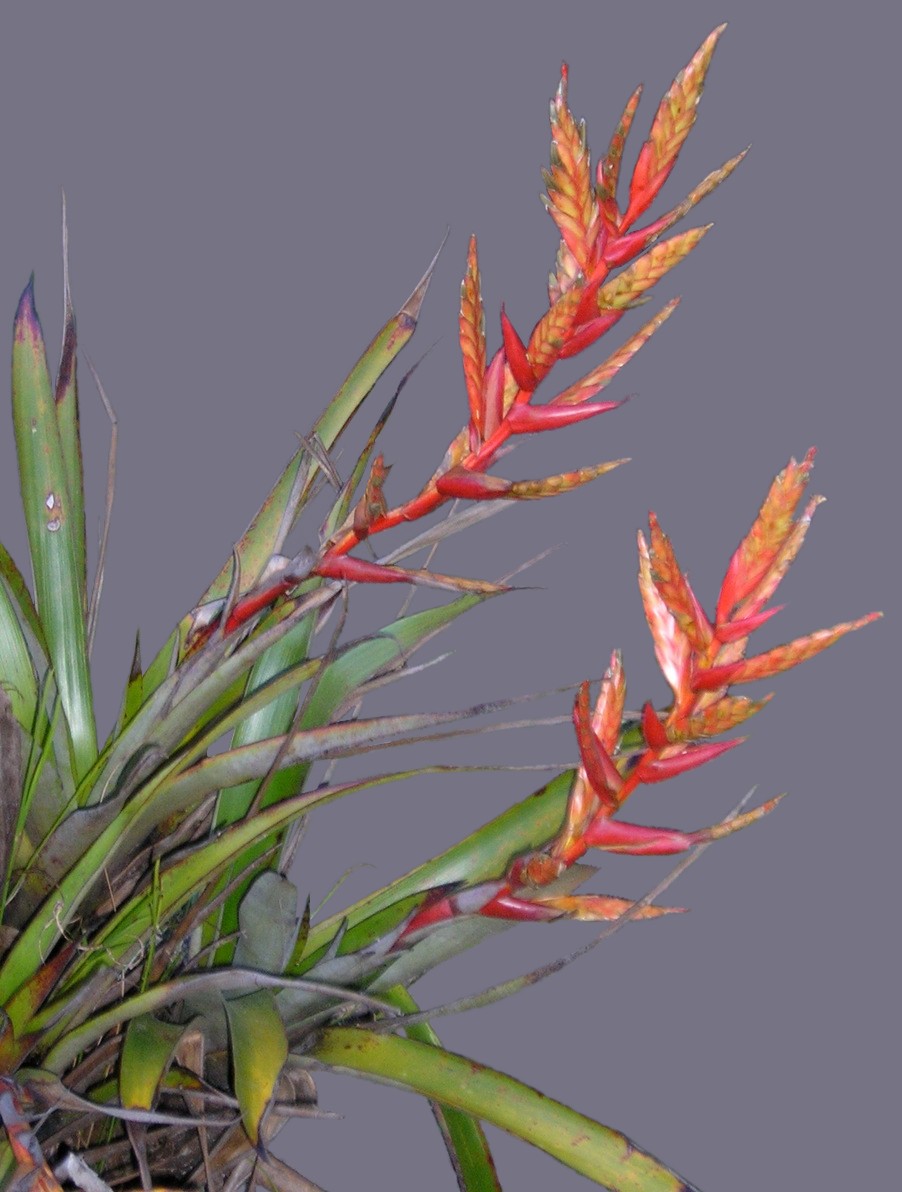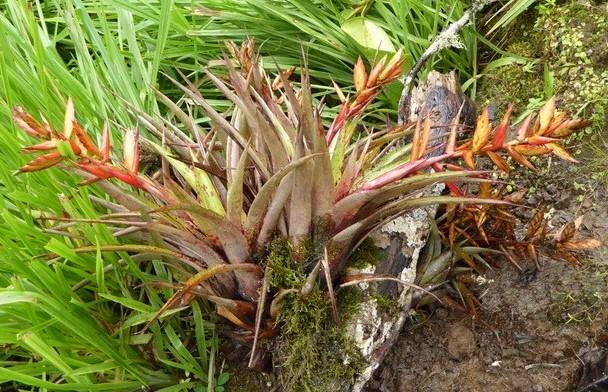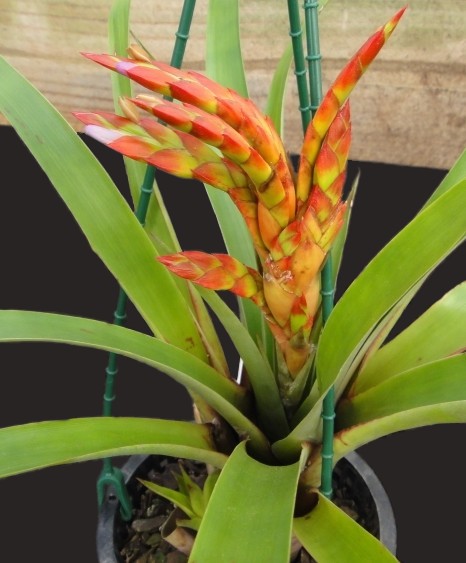


Tillandsia confinis L. B. SMITH var. minor J. Rutschmann et Rauh , Trop Subtrop. Pflanz.65: 47-49. 1988 treated as a synonym in Binomial listing 6. 1998
A typo var. confinis differt habitu minore, vaginibus multo minoribus, laminis mollissimis, inflorescentiis minoribus et petalis atroviolaceis.
Holotypus: B.G.H. 68537, leg. Dr. J. Rutschmann (Basel), s.n., in herb. inst. bot. system. univ. heidelb. (HEID).
Patria et distributio: epiphytica in arboribus generis Coffeae vetustis apud 1000 m.s.m., inter Loja et Machala, Aequatoria meridionalis.
Differs from the type var. confinis by the smaller growth, the much smaller sheaths, the very soft blades, the smaller inflorescence and the dark-violet petals.
Holotype: B.G.H. 68537, leg. Dr.J. Rutschmann (Basel), o. Nr., im (HEID).
Habitat and range; Epiphytic on coffee trees near 1000 m, between Loja and Machala, south Ecuador.
Plant growing in groups, stemless, flowering to 30 cm high.
Leaves numerous, forming a funnel-rosette to 20 cm high and 15 cm wide.
Sheath ± distinct, long-oval, to 3-4,5 cm high and 2-2,5 cm wide, bleached, occasionally upper side somewhat violet, on both sides appressed scattered lepidote, therefore appearing green.
Blades very soft, narrow-triangular, above the sheath 1,5 cm wide, 13-15 cm long, long-attenuate, bent over in the upper part, upper side lax, underneath densely scaled; scales with brown centre.
Inflorescence bipinnate, erect to slightly bent over.
Scape thin, 3 mm thick, greenish reddish. glabrous.
Scape bracts: the basal ones subfoliate, the upper ones with long, vermilion sheath and green bent over blade.
Inflorescence to 12 cm long, 8 cm wide, with 4-7 spreading spikes.
Primary bracts: the basal ones similar to the upper scape bracts, the upper ones wide-oval, long acuminate, pale carmine red, upper side scattered appressed lepidote, underneath glabrous, only lepidote towards the tip, shorter than the spike;
Spikes with short stem and sloping peduncle bract, longish-lanceolate, 4-5 cm long, 1 cm wide, acuminate, complanate, 6 to 10- flowered.
Inflorescence rhachis angular, glabrous, straight, reddish green.
Spike rhachis green, flattened on the side, glabrous, at anthesis not visible.
Floral bracts densely imbricate, carinate, longish oval, acuminate, 1.5 cm long, 0.8 cm wide, green, smooth, glabrous, only at the tip weakly lepidote, partly waxy scurf, longer than the sepals;
Sepals narrow lanceolate, the posterior pair carinate, ? connate, bleached geeen, 14 mm lang.
Petals narrow tongue shaped, acuminate, dark-violet, with short bent over platte, the bottom white.
Stamens and Style enclosed, Filament plicate, stigma spreading, white, papillose.
T. confertiflora Ed. Andre, Enum. Bromel. 7. 13 Dec 1888.
Description:
Folia radicalia plana, ad basin Iate dilatatam amplectentia, lanceolata, ad apicem setacea, striata, presertim pagina inferiore copiose lepidota. Scapus 30 cent. altus, foliis bractealius crebris, imbricatis, lanceolato-setaceis, foliis radicalibus subsimilibus, Panicula densissima, spicis circ.12 ad partem superiorem scapi confertis, Bracteae primariae glabrae: inferiores lanceolatae, spicis apice
longe setaceis longiores, summae breviores, ovato-acuminatae, Spicae distichae, densissimae, compressae, ovatae, 3-4 cent. longae, 12-14-florae. Bracteae florales ovatae, acutissimae, 18 mill, longae, valde carinatae, glabrae. Flores arcuati. Sepala oblonga, acutissima, carinata, bracteam subaequantia: duo ultra medium coalita, tertium liberum. Flores luteo-albidi. Capsula arcuata, bracteam paulo superans.
Basal leaves flat, widely dilated, clasping, lanceolate and ending in a bristly point, striped, grayish, very abundantly covered with scales especially above.
Scape 30 cm tall, covered with numerous overlapping, lanceolate-bristly, bract-like leaves looking like the basal leaves.
Panicle very dense, formed of about 12 spikes, gathered at the top of the scape.
Primary bracts glabrous; the lower lanceolate and ending in a long point, overtopping the spike; the upper shorter and ovate-acuminate.
Spikes in two rows, very dense, flat, ovate, 3 - 4 cm long, composed of 12-14 flowers.
Floral bracts ovate and very sharply pointed, 18 mm long, strongly keeled, glabrous.
Flowers arched.
Sepals oblong, very acute, keeled and about as long as the bract; one is free to the base, two are fused up to the middle.
Flowers whitish-yellow.
Capsule arched, slightly longer than the bract.
Epiphytic in the central Ecuadorian Andes at 2500 to 3000 m altitude. (Andre's Herbarium, no. 4475 bis.)
T. rubella Baker, collected by Mandon at Sorata, Bolivia, and having an inflorescence resembling that of the above species, is distinguished from it by several characteristics, especially by the short, soft leaves without scales, pale green but red at the tip, etc.
From Baker 1889
90. T. CONFERTIFLORA Andre Enum.7.
Root-leaves lanceolate-acuminate, densely lepidote- beneath.
Stem a foot long;
bract-leaves lanceolate-setaceous, imbricated.
Panicle very dense, formed of about a dozen dense distichous 12-14-flowered spikes 1- 1 ½ in. long;
lower branch-bracts lanceolate-setaceous, longer than the spikes;
flower-bracts ovate, acute, 5/8 in. long.
Sepals oblong, very acute.
Petals yellowish-white.
capsule arcuate, rather longer than the bract.
Hab. Andes of Central Ecuador, Andre 4475, bis.
From Mez 1935
250. T. confertiflora Andre in Rev. Hortic. LX. (1888) 567 et Bromel. Andr. (1889) 90, t. 26, fig. A.
- 0,3-0,4 m alta. Folia haud bulboso-rosulata, ad 0,3 m longa, super vaginas ad 30 mm lata, inde in apicem peracutum sensim angustata, praesertim subtus copiose lepidota. Scapus erectus, folia aequans vel iis brevior, dense vaginis lanceolatis,
imbricatis, internodia superantibus indutus. Inflorescentia compacte 2-pinnatim panniculata, submulti- vel multiflora, densissima, ad 0,1 m longa et 70 mm diam. metiens, ellipsoidea; spicis suberectis, flabellatis, 12-14-floris, subsessilibus, ovato-ellipticis, parum complanatis, utraque facie fere convexiusculis, apice subacutis, ad 35 mm longis et 20 mm latis; bracteis primariis inferioribus mediisque sueto in laminam brevem productis, his saltem spicas axillares bene superantibus; bracteis florigeris dense imbricatis, peracute carinatis, rigidis, glabris laevissimisque, ad 22 mm longis, sepala longe superantibus. Flores erecti, ad 20 mm longi; sepalis antico libero posticis fere medium usque connatis, chartaceis, lanceolatis, longe acutis, ad 16 mm longis. Petala luteo-albida, stamina superantia.
Ecuador: ohne nahere Ortsangabe, in Anden von Central-Ecuador (Andre n. 4475 bis), Prov. Riobamba, bei S. Jorge (Sodiro n. 20), bei Chinchanga (Poortman n. 478).
Plant stemless, 3-7 dm high.
Leaves many in an infundibuliform rosette, 3-4 dm long;
Sheaths ample, elliptic, 13-20 cm long, inconspicuously punctulate-lepidote, smooth and sublustrous, pale green splotched with dark purple especially on the inner face;
Blades straight, narrowly triangular, attenuate, 25-35 mm wide, covered beneath with minute appressed cinereous scales, soon glabrous above.
Scape erect, slender, glabrous;
Scape-bracts strict, imbricate, subfoliaceous, the upper ones with red sheaths.
Inflorescence laxly bipinnate; primary bracts broadly ovate, the lower ones caudate, the upper apiculate;
Spikes spreading, linear-lanceolate, 6-10 cm long, 15-20 mm wide, strongly complanate, 8-14-flowered with 2-3 sterile bracts at the base.
Floral bracts strongly imbricate and concealing the rhachis, lance-oblong, acute, sharply carinate, 18-24 mm long, exceeding the sepals, even, lustrous, glabrous or nearly so;
Pedicels 1 mm long.
Sepals linear, acute, 17-22 mm long with the posterior ones semi-connate, keeled, nerved, subchartaceous, sparsely lepidote with minute appressed brown scales;
Petals white, the blades 7 mm long;
Stamens included.
Capsule slenderly cylindric, beaked, 27-40 mm long.
Tillandsia confinis var confinis
Tillandsia subtropicalis L. B. Smith, Phytologia 8: 505, pl. 3, figs. 8-10. 1963. Type. Hacienda Casana, Tipuani, Larecaja, La Paz, Bolivia, Buchtien 7185 (US), 5 Aug 1922.
Inflorescence 7-28 cm long;
Lower primary bracts caudate but shorter than the axil¬lary spikes.
Type. Ferreyra 1686 (holotype USM), Tingo Maria to Pucallpa, Loreto, Peru, 28 Feb 1947.
DISTRIBUTION. Epiphytic in forest, 600-2800 m alt, northwestern South Ameri-ca. COLOMBIA. MAGDALENA: Codazzi, Espiritu Santo Valley, Sierra de Perija, 14 Feb 1945, Grant 10934 (COL, US). ANTIOQUIA: Rio Dolores above Angostura, Lehmann 7592 (K). VENEZUELA. ZULIA: Perija, 29 Dec 1950, Gines 1984 (US). Amazonas: Rio Yatua, Cerro de la Neblina, 13 jan 1954, Maguire, Wurdack & Bunting 37287 (NY, US); Raudal Gallineta, Rio Siapa, 21 Ju1 1959, Wurdack & Adderley 43561 (NY, US). ECUADOR. LOJA: Hacienda Horta-Naque, 11 Oct 1946, Espinosa E-1039 (GH). NAPO: Mera, Mar 1956, Asplund 19613 (S); 19952 (S); Talag, Tena, 9 Jul 1960, Grubb et al 94 (K, OXF, US). BOLIVIA. LA PAZ, Larecaja: Hacienda Casana, Tipuani, 15 Oct 1922, Buchtien 7187 (US). BRAZIL. AMAZONAS: Serra de la Neblina, 1966, Silva & Brazao 60942 (NY, US).
Tillandsia subtropicalis L. B. Smith, Phytologia 8: 505, pl. 3, figs. 8-10. 1963. See above
A T. kuntzeana Mez, cui affinis, foliorum laminis supra glabris, scapi bracteis glabris, bracteis florigeris haud incurvatis, floribus multo minoribus differt.
Stemless, flowering 3 dm, high;
leaves 15 or more in a funnelform rosette, 20-23 cm, long;
sheaths broadly elliptic, 6-7 cm. long, dark castaneous, densely and minutely appressed-lepidote;
blades ligulate with a long attenuate apex, 15-20 mm, wide, covered beneath with fine appressed cinereous scales, glabrous above;
scape erect, slender;
scape-bracts densely imbricate and concealing the scape, the lowest subfoliaceous, the others elliptic, glabrous and lustrous except for the small narrow blade;
inflorescence laxly bipinnate from 5-7 spikes, glabrous;
primary bracts ovate, about half as long as the spikes;
spikes subspreading, subsessile, lanceolate, acute, 45 mm. long, 12 mm. wide, strongly complanate, dense;
floral bracts imbricate and wholly concealing the rhachis, ovate, acute, 18 mm long, sharply carinate with a straight apex, coriaceous, even, lustrous;
sepals lanceolate, acute, 15mm. long, the posterior carinate, 2/3 connate.
P1. III, fig. 8: Apex of leaf x 1/2; fig. 9: Inflorescence x 1/2; fig. 10: Posterior sepals x 1.
Type in the U. S. National Herbarium, collected in the sub tropical region, at Hacienda Casana on the road to Tipuani, Department of La Pas, Bolivia, 1400 metres altitude, August 5. 1922, by 0. Buchtien (no. 7185).
BOLIVIA: Same as type, October 15, 1922, Buchtien 7187 (US).
Tillandsia confinis var caudate L. B. Smith, Phytologia 8: 499. 1963.
Tillandsia abysmophila Smith & Steyermark. Annals of Missouri Bot. Garden, Vol 73, 714-5, 1986
Inflorescence 3 dm long;
Lower primary bracts to 15 cm long, their caudate-attenuate blades much exceeding the axillary spikes but their sheaths much shorter.
Type. Romero-Castarieda 7323 (holotype US, isotype COL), Sabania Rubia, Manaure road, Mun. Robles, Serrania de Perija, Magdalena, Colombia, 3 Mar 1959. DISTRIBUTION. Epiphytic in forest, 2700-2800 m alt, Colombia.
COLOMBIA. MAGDALENA: Quebrada de Floridablanca, Manure. Sierra de Perija, 11 Nov. 1959, Cuatrecasas & Romero-Castaneda 25244 (US).
Tillandsia abysmophila L. B. Smith & Steyermark, Annals of Missouri Bot. Garden, Vol 73, 714-5, 1986 TREATED AS A SYNONYM OF T. confinis var. caudate BY SMITH & TILL in Phytologia 63:438.1987
TYPE: Venezuela. Amazonas: Dept. Rio Negro, Cerco Aratitiyope, epifita en selva alta, a lo largo de un riachuelo afluente a Rio Manipitare; 990-1,670 m alt., Lat. 2°10' N, Julian A. Steyermark, Paul Berry & Francisco Delascio 130135 (holotype, US; isotypes, NY, VEN).
Verisimiliter acaulis, florifera ca. 6 dm alta. Folia ca. 5 dm longa, subtus squamis adpressis cinereis in centro atris dense vestita; vaginis ellipticis, 10 cm lon¬gis, supra lepidotis; laminis ligulatis, acuminatis, 3 cm latis, supra glabris.
Scapus erectus, gracilis; scapi bracteis subfoliaceis, dense imbricatis. Inflorescentia laxe bipinnatim paniculata, 26 cm longa, glabra; bracteis primariis late , ovatis, quam spicis brevioribus, inferioribus lineari-laminatis; spicis divergentibus, sessilibus, lineari-lanceolatis, 8.5 cm longis, 1.5 cm latis, complanatis. Bracteae florigerae ovatae, acutae, 25 mm longae, carinatae, rigidae, laevigatae. Sepala linearia, acuta, 22 mm longa, bracteis florigeris inclusa, posteriora carinata, alte connata.
SECTION OF SUBKEY IX
46a. Plant flowering 1-2 m high; primary bracts lanceolate, acute. Colombia, Ecuador, Peru - 9: T. pyramidata
46a. Plant flowering ca. 0.6 m high; lower pri¬mary bracts linear-laminate. Venezuela. - 9.1. T. abysmophila
Plant very likely acaulis, flowering to 60cm high.
Leaves ca 50cm long, underneath with grey appressed scales with dense dark centres.
Sheaths elliptic, 10cm long, lepidote on the upper side.
Blades ligulate, acuminate, 3cm wide, upper side glabrous.
Scape erect, slender.
Scape bracts sub-foliate, densely imbricate.
Inflorescence laxly bipinnate panicle, 26cm long, glabrous.
Primary bracts wide ovate, shorter than the spikes, lower ones with linear blades
Spikes divergent, sessile, linear-lanceolate, 8.5cm long, 1.5cm wide, complanate.
Floral bracts ovate, acute, 25mm long, carinate, rigid, smooth and polished.
Sepals linear, acute, 22mm long, enclosed by the floral bracts, posterior pair carinate, high connate.
Tillandsia confinis var. minor Rutschmann & Rauh Trop. Subtrop. Pflanzenwelt 65:47-9 1988 treated as a synonym of T. confertiflora in Binomial listing 6. 1998